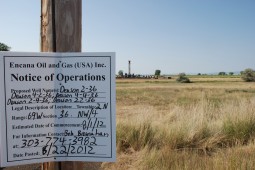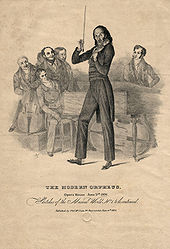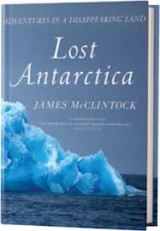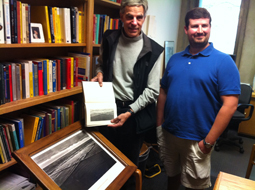
Hosts: Jim Pullen and Joel Parker
Producer: Jim Pullen
Engineer: Jim Pullen
Executive Producer: Jim Pullen
Podcast: Play in new window | Download (Duration: 23:21 — 21.4MB)
Subscribe: RSS
The KGNU Science Show

Hosts: Jim Pullen and Joel Parker
Producer: Jim Pullen
Engineer: Jim Pullen
Executive Producer: Jim Pullen
Podcast: Play in new window | Download (Duration: 23:21 — 21.4MB)
Subscribe: RSS

Hosts: Jim Pullen and Joel Parker
Producer: Jim Pullen
Engineers: Jim Pullen, George Figgs, and Dafe Hughes
Executive Producer: Jim Pullen
Podcast: Play in new window | Download (Duration: 24:28 — 22.5MB)
Subscribe: RSS
 We talk with Travis Metcalfe, of Boulder’s Space Science Institute, where he is searching for Sister Earth and also part of the Blue Dot Project. As for why, the past two decades have witnessed accelerating progress on one of the most fundamental questions in astronomy: Are we alone in the Universe? Astronomers have already discovered hundreds of planets around distant stars. Some of them are nearly as small as the Earth, and orbit in the “Goldilocks zone” of their parent star where liquid water can exist.
We talk with Travis Metcalfe, of Boulder’s Space Science Institute, where he is searching for Sister Earth and also part of the Blue Dot Project. As for why, the past two decades have witnessed accelerating progress on one of the most fundamental questions in astronomy: Are we alone in the Universe? Astronomers have already discovered hundreds of planets around distant stars. Some of them are nearly as small as the Earth, and orbit in the “Goldilocks zone” of their parent star where liquid water can exist.
 We congratulate Boulder’s David J. Wineland for winning the 2012 Nobel Prize in physics. Wineland, a physicist at the National Institute of Standards and Technology and CU-Boulder, shares the prize with and Serge Haroche of France. They are credited with making breakthroughs in quantum physics by showing how to observe individual quantum particles without destroying them. These, in turn, are the first steps toward building superfast computers based on quantum physics.
We congratulate Boulder’s David J. Wineland for winning the 2012 Nobel Prize in physics. Wineland, a physicist at the National Institute of Standards and Technology and CU-Boulder, shares the prize with and Serge Haroche of France. They are credited with making breakthroughs in quantum physics by showing how to observe individual quantum particles without destroying them. These, in turn, are the first steps toward building superfast computers based on quantum physics.
Hosts: Joel Parker, Beth Bartel
Producer: Shelley Schlender
Engineer: Jim Pullen
Executive Producer: Jim Pullen
Podcast: Play in new window | Download (Duration: 24:17 — 33.4MB)
Subscribe: RSS
 Feature #1: Neanderthals (start time: 6:01)
Feature #1: Neanderthals (start time: 6:01)
Our Neanderthal ancestors have long been maligned as rather dim-witted cave-dwellers. But they may have been brighter — and more colorful — more like us, shall we say. We turn to the BBC’s Science in Action for a look at new research into who these ancestors really were. Here’s BBC’s Jon Stewart.
Feature #2: Antarctica (start time: 11:03)
It may be hard for people living in Colorado and other land-locked states to grasp that our daily lifestyles – burning fossil fuels every time we turn on the lights or drive our car, for instance – affects the delicate marine ecosystems of the Southern Ocean, from the ice algae to the penguins and whales. And in turn, the health of the plants and animals, and indeed the ice they depend on, in Antarctica, affects our own health. Cohost Susan Moran interviews Dr. James McClintock, a marine biologist at the University of Alabama in Birmingham, about his new book, “Lost  Antarctica: Adventures in a Disappearing Land.” He shares his adventures waaayy down under, and his concerns about the future of the fragile and stunning continent.
Antarctica: Adventures in a Disappearing Land.” He shares his adventures waaayy down under, and his concerns about the future of the fragile and stunning continent.
Hosts: Ted Burnham, Susan Moran
Producer: Susan Moran
Engineer: Joel Edelstein
Executive Producer: Jim Pullen
Podcast: Play in new window | Download (Duration: 24:06 — 22.1MB)
Subscribe: RSS

Big Waves (start time 4:39): When does one plus one not equal two? When waves behave non-linearly, according to CU researchers Mark Ablowitz and Douglas Baldwin. The two have been researching how multiple water waves can add together to form a wave with a height much greater than twice the height of either wave. The mathematicians refer to these as X and Y waves, which sounds mathematical but actually just refers to the shape of the wave front as seen looking down on the wave from above. Rather than being rare, these waves are readily observable and may be the reason that some tsunamis are much larger than anticipated. We spoke yesterday with the pair to find out more about these interesting waves.

Omega 3 Fatty Acids (start time 14:49): It’s widely accepted that Omega 3 supplements are good for many things, especially your heart, and that fish oil is high in Omega 3. But earlier this month, Greek researchers made a splash with a meta-analysis that concluded that fish oil supplements do not help your heart. They came to this conclusion even though, in their analysis, people taking fish oil pills or eating fish had 9 percent fewer deaths from heart disease and 11 percent fewer heart attacks than people who don’t. Fans of Omega 3 shot many other harpoons into the study, and we look at one of their most compelling complaints – it’s that the amount of Omega 3 that people’s bodies absorb depends on many things, and the Greek scientists did not examine studies that checked Omega 3 fatty acids levels where they count the most. That’s in people’s blood. To find out more about why blood levels of Omega 3’s might matter, How On Earth’s Shelley Schlender talks with Doug Bibus. Bibus is part of the team that years ago basically discovered Omega 3s. He’s a two-time winner of the American Chemical Society’s Award in Analytical Chemistry. Bibus says that most Americans have very low levels of Omega 3s, and they’d be healthier if their levels were higher.
Hosts: Beth Bartel, Joel Parker
Producer: Beth Bartel
Engineer: Joel Parker
Executive Producer: Susan Moran
Podcast: Play in new window | Download (Duration: 24:46 — 34.0MB)
Subscribe: RSS

Colorado Drought Conference (start time 4:35): Experts are meeting at a conference in Denver this week to discuss the implications of prolonged drought conditions here in Colorado. How On Earth’ Susan Moran speaks with biologist Dr. Chad McNutt of the NOAA’s National Integrated Drought Information Center about wthe drought means for the ecosystem, and for Western cities — and how we can start to address the problem.
A More Perfect Heaven (start time 11:50): Joel Parker speaks with Dava Sobel, a science journalist and author who tells the stories of the science and the scientists from the past and how they connect to the present. Those stories reveal that the course of scientific progress is far from orderly — it often takes unplanned twists, has failures that require going back and starting over, and can be driven by the quirks of the personalities of individual scientists.
Today we hear about Sobel’s most recent book, A More Perfect Heaven: How Copernicus Revolutionized the Cosmos. This book also contains the play And The Sun Stood Still, which will be presented in a free staged reading by the Boulder Ensemble Theatre Company this Thursday, September 20th at 6:30 at the Dairy Center for the Arts.
Hosts: Ted Burnham, Joel Parker
Producer: Ted Burnham
Engineer: Jim Pullen
Executive Producer: Susan Moran
Podcast: Play in new window | Download (Duration: 22:38 — 20.7MB)
Subscribe: RSS

We’ll talk about the World of a tiny particle called the Higgs-Boson, with CU Physicist Uriel Nauenberg. Nauenberg also speaks tonight at the Boulder Cafe Scientifique.
Hosts: Joel Parker and Ted Burnham
Producer: Shelley Schlender
Engineer: Jim Pullen
Executive Producer: Susan Moran
Podcast: Play in new window | Download (Duration: 23:49 — 32.7MB)
Subscribe: RSS
 Bell Labs thrived from the 1920s to the 1980s, when it was most innovative and productive institution of the twentieth century. Long before America’s brightest scientific minds began migrating west to Silicon Valley, they flocked to the Bell Labs campus in the New Jersey suburbs. At its peak, Bell Labs employed nearly fifteen thousand people, twelve hundred had PhDs. Thirteen eventually won Nobel prizes. How did they do it? How can we learn from their successes, so we can do it here in Colorado? New Your Times journalist Jon Gertner has written a book that provides some answers. He calls it: The Idea Factory – Bell Labs and the Great Age of American Innovation. Inside that book, you can learn how radar came to be, and lasers, transistors, satellites, mobile phones, and much more. How on Earth’s Shelley Schlender spoke with Mr. Gertner about his new book.
Bell Labs thrived from the 1920s to the 1980s, when it was most innovative and productive institution of the twentieth century. Long before America’s brightest scientific minds began migrating west to Silicon Valley, they flocked to the Bell Labs campus in the New Jersey suburbs. At its peak, Bell Labs employed nearly fifteen thousand people, twelve hundred had PhDs. Thirteen eventually won Nobel prizes. How did they do it? How can we learn from their successes, so we can do it here in Colorado? New Your Times journalist Jon Gertner has written a book that provides some answers. He calls it: The Idea Factory – Bell Labs and the Great Age of American Innovation. Inside that book, you can learn how radar came to be, and lasers, transistors, satellites, mobile phones, and much more. How on Earth’s Shelley Schlender spoke with Mr. Gertner about his new book.
Hosts: Tom McKinnon and Jim Pullen
Producer: Tom McKinnon
Engineer: Jim Pullen
Executive Producer: Susan Moran
Podcast: Play in new window | Download (Duration: 23:42 — 21.7MB)
Subscribe: RSS

Hosts: Jim Pullen and Susan Moran
Producer: Jim Pullen
Engineer: Maeve Conran
Executive Producer: Susan Moran
Podcast: Play in new window | Download (Duration: 25:10 — 23.1MB)
Subscribe: RSS

 Planetary science budget (start time: 15:49). Despite the successes of the Mars missions and voyages to our other planetary neighbors, the White House decided that NASA’s planetary science budget should be drawn down. The hit would be substantial, a twenty percent reduction from 2012. 300 million dollars would be removed from a baseline one and a half billion dollars. We ask Dr. Alan Stern, who has served as the chief of the Science Mission Directorate at NASA, about why the planetary science budget should be restored.
Planetary science budget (start time: 15:49). Despite the successes of the Mars missions and voyages to our other planetary neighbors, the White House decided that NASA’s planetary science budget should be drawn down. The hit would be substantial, a twenty percent reduction from 2012. 300 million dollars would be removed from a baseline one and a half billion dollars. We ask Dr. Alan Stern, who has served as the chief of the Science Mission Directorate at NASA, about why the planetary science budget should be restored.
Hosts: Jim Pullen and Shelley Schlender
Producer: Jim Pullen
Engineer: Shelley Schlender
Executive Producer: Susan Moran
Podcast: Play in new window | Download (Duration: 25:39 — 35.3MB)
Subscribe: RSS